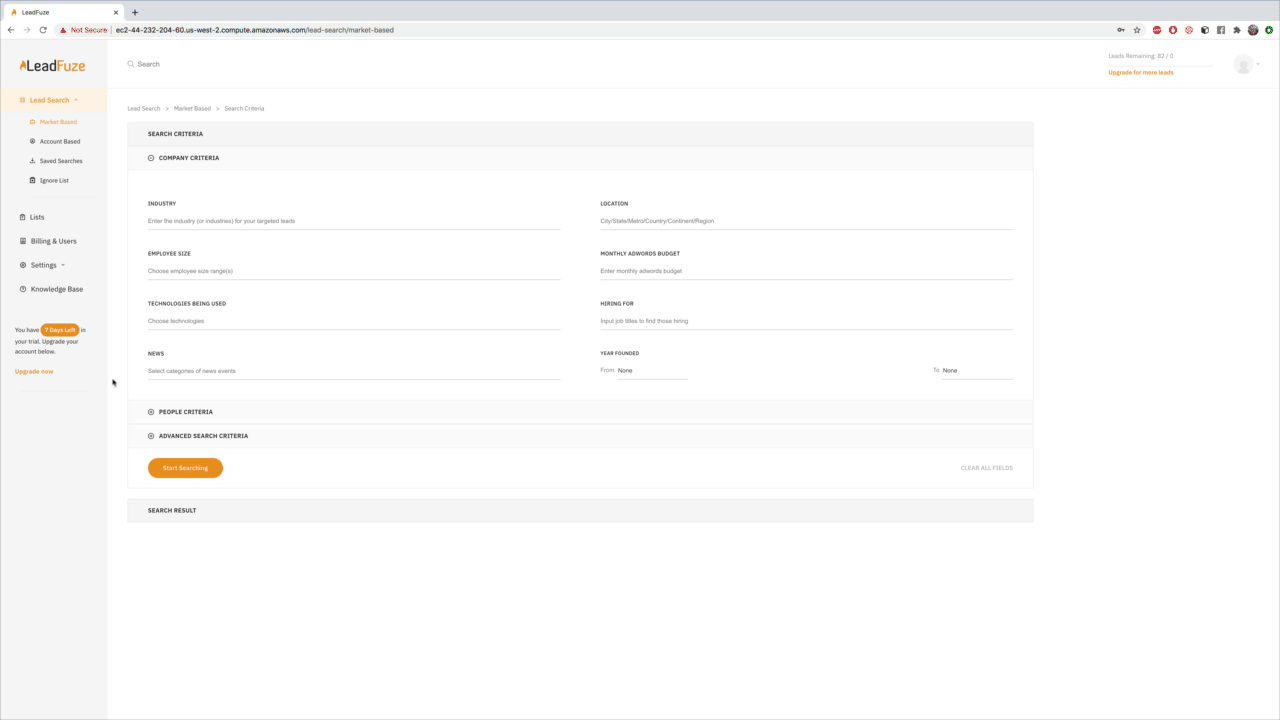Importance of Sales Team Management
Sales team management is important to any organization that relies on its sales team to bring in revenue. A strong, well-managed sales team will always outperform a weak and poorly managed one.
Sales teams are complex groups of people with individual goals, motivations, preferences, strengths and weaknesses which all need consideration when managing them effectively.
You’ll find your team progressing through sales stages smoothly, converting leads into accounts before you can say: “revenue growth.”
However, in order to get to that stage, it’s important to set the right foundations and know how to manage sales representatives throughout the sales process.
Thus, this article will help you decide how to assign leads and prospecting responsibilities, as well as show you how you can optimize the 7-step sales process for your representatives.
The key to success starts from the very first step and below we’ll show you how your sales team can be the best.
How to Build Your Sales Team
When building your sales team, you should find not only one right candidate, but multiple.
The ideal sales representative is the one who can do both the prospecting and the closing, especially if you’re in a dynamic field of work. This is beneficial because the representative is familiar with the development of a converted customer from lead to prospect.
They can track the customer’s progress through stages, and having their unique needs in mind, personalize offers and communication to be the best fit.
Depending on your needs and your budget, the number of sales representatives you hire may vary. Ideally, you want to have two representatives to start with.
This is especially significant when it comes to competition.
Even though natural-born salespeople are very competitive by their very nature, it’s good to have competition for motivation.
Additionally, it’s good for each rep to have their own VA for research and prospecting. This allows them to pay more attention in the processes of organizing data, scheduling meetings with leads, and closing deals.
7 Steps in Sales Team Management
If you’re building a sales team, you should lay down the rules when it comes to responsibilities.
This isn’t as important if you’ve got a small team that covers one lead type in one territory.
However, if you operate in different territories, locations, or industries, it’s good to assign lead and prospecting responsibilities as soon as possible. This will eliminate any confusion further down the line, and enable everyone on your team to focus on their set of tasks and responsibilities, without confusing overlapping.
Your goal is to make the process and rules as clear as possible so your sales team can focus on what they do best: selling.
The best way to do it is to hire the right people, establish rules, and assign responsibilities from the very start.
Only then is your sales personnel ready for…
Step 1: Prospecting
The first step of the typical sales process you’ll encounter is prospecting.
Prospecting is the search for potential customers in order to advance them through the sales process and ultimately, convert them to customers.
Keep in mind that leads and prospects aren’t one and the same. Leads are people who’ve only shown interest in your product, while prospects are qualified leads who align you’re your targeting criteria.
Prospects are usually people who satisfy the BANT qualifying criteria:
- Budget
- Authority
- Need
- Timing
This means that your prospect should have a budget, the authority to make a decision to buy from you, a need for your product, and would do it in a set timeframe.
Your sales representative should check whether the prospect satisfies the criteria before engaging with them further.
Typically, there are two types of people your sales rep may encounter in this stage:
Decision-makers
The people that satisfy all the necessary criteria, and can be negotiated with further. They have the power to make the decision about buying from you.
Gatekeepers
These are people who are obstructing your rep’s path toward the decision-makers. Usually, they’re personal assistants or secretaries.
The existence of gatekeepers is the reason why your sales representatives can use tools like LinkedIn’s Sales Navigator.
Sales Navigator, for example, allows your reps to reach the right prospects with search and filter features. This eliminates gatekeepers from the process and increases sales velocity.
At the end of this stage, your representative should have a qualified prospect they can advance through the sales pipeline.
Are you looking for a new way to prospect?
LeadFuze is the best way to find prospects and get them on the phone. It offers an easy-to-use, intuitive interface that allows you to search for leads by company name or industry, as well as set up alerts so you never miss out on any potential opportunities. Its lead generation platform also offers powerful reporting features so you can see exactly what’s working and what isn’t. You won’t have to spend hours every day searching through databases anymore!
With LeadFuze, your time will be spent doing more of what matters most – talking with prospects about their needs and how they can solve their problems with your products or services.
Step 2: Preparation and research
Once your sales representatives have identified prospects (with or without the help of their VAs), it’s time for them to prepare for approaching them.
This is where personalization is very important. 74% of customers feel frustrated when content is not personalized, and this is only emphasized in sales.
That’s why it’s important for sales representatives to do their due diligence before approaching a prospect.
Preparation and research include:
1) Researching the market
2) Collecting all information about the product relevant to the customer
3) Developing the sales presentation, and customizing it to fit a customer’s particular needs
Since information about the client’s needs was retrieved during the prospecting step, this step should analyze intelligence, as well as other relevant information about products and the market at large.
When your sales representatives filter that information, they should be able to tailor their approach to the prospect at hand.
This can mean:
- Pitching with this client’s pain points in mind
- Adjusting the format (e.g. presentation vs phone call vs event)
If done right, research can go a long way towards answering all the questions a prospect has, and advancing them through the sales process faster.
At the end of this stage, your sales representative should have all the necessary information for tailoring their approach and presentation to the prospect.
Step 3: Approach
After prospecting and preparation, the next stage is building a relationship with the prospect.
Stage 3 (Approach) is where a sales representative will approach the prospect with an offer. In this stage, it’s incredibly important to educate the prospect on all the benefits of a product, and apply the gathered intelligence.
Depending on the format that best suits the prospect, a sales representative can choose one of the three common approaches:
Premium approach
This is an approach where a prospect is given a gift at the beginning, in order to warm them up.
Question approach
If anything is common, then it’s this approach. Asking a question at the beginning of a call or a meeting evokes interest in a prospect.
Product approach
One of the best ways to approach a customer may be by offering them a sample or a trial of the product.
When deciding on possible approaches, it’s good to work with your sales representatives. They should have clear guidelines on what they can and can’t do, with a particular emphasis on the latter.
This also depends on your product, and whether it’s possible for prospects to test it before buying.
The sales approach your representative chooses also depends on their personal preference. There are incredible salespeople who opt for a hard-seller technique, while others can do a lot by listening and turning into the prospect’s friend in a second.
Give the salespeople you manage enough leeway to tailor their approach. Share on XThere’s no right way to approach a prospect, so it’s good to give the salespeople you manage enough leeway to tailor their approach.
At the end of this stage, a prospect should have a clear way to advance towards the next step. This can either be a trial of the product, a brochure, or any other action they can take.
Step 4: Presentation
Presentation and approach sometimes get mixed up, but the right sales representative should understand the difference.
The approach is a way to start a conversation, while the presentation is a demonstration of why the prospects wants to keep talking.
In the presentation phase, a sales representative will directly address this prospect’s pain points, and demonstrate the benefits of the product for addressing these particular problems.
If they’ve done research right, they’ll be able to explain why it’s in the prospect’s best interest to use your product.
Even though the name of this stage is presentation, often it means listening to the prospect’s needs and addressing them by showing how the product can solve them.
There are 5 aspects to a successful sales presentation:
1. Customer knowledge (understanding what the customer needs, and how they’d like to be treated)
2. Motivation knowledge (why the customer has a need for this product)
3. Product knowledge (the sales rep should know everything about the product)
4. Competition knowledge (understanding the benefits of your product, as opposed to its competition)
5. Value knowledge (the sales representative should know how to present the features of the product in a way that shows the customer what value and benefits they’re getting)
If all five are combined to make up the presentation, the prospect should be informed enough to advance towards the next stage.
At the end of this stage, the prospect should have all the necessary information about the product, and the personal benefits they’d get by buying it.
Step 5: Handling objections
Most of the time, prospects have additional questions. This isn’t bad. In fact, it’s good, as it shows that the prospect is considering the product seriously.
Your sales representatives should have enough product and customer knowledge to be able to listen and address the prospect’s concerns.
Rejection also occurs in this phase. However, a qualified sales representative should be able to define what type of rejection they’re getting.
There are:
1) Hard rejections (where it’s pointless to keep negotiating, as the prospect has either been poorly qualified earlier in the process or their level of criteria satisfaction decreased)
2) Rejections due to cost (where it’s possible to compare the product to competitors, offer a free trial or a discount, or emphasize the value the prospect is getting)
3) Rejections due to timing (make a limited-time offer)
4) Rejections due to fear of change (emphasize product benefits, statistics, etc.)
5) Rejections due to contracts with competitors (compare the product with competitors)
6) Rejections due to lack of information (offer more information)
Handling objections is the key stage in the sales process, and if a sales representative successfully overcomes it and turns a prospect into a client, it’s a definite sign they’re highly qualified.
At the end of this stage, a prospect should be ready to move forward and commit.
Step 6: Closing
Closing should always come as a natural step after a successful product presentation. It’s a sign that the prospect is well-informed, and has been approached the right way.
Even though the best way to close is by doing it without pressure, there are three most commonly used strategies:
1) Alternative choices
The prospect is offered a choice where both options mean a sale.
2) Extra motivation
The prospect is offered something in addition to the product in order to motivate them to buy.
3) Urgency
Inducing urgency can be a very effective way to close, as the prospect is told that it’s a limited offer, and if they want the product, they should commit as soon as possible.
The key to effective closing is in the handling objections phase. If the objections have been addressed properly, there’ll be no reason for the prospect not to turn into a customer.
That’s why it’s important for the sales representative and their associates to pay particular attention in the prospecting and research stage.
At the end of this stage, a prospect should be ready to buy. If they aren’t, they should agree on the next point of contact with the sales representative.
Step 7: Follow-up
The sales process doesn’t end when the product is sold to a customer.
Since repeat customers make up for 40% of revenue, it’s in your best interest for your sales representatives to keep in touch with the new customers for referrals and repeat sales.
It’s also good to obtain social proof from happy customers at this stage. Prospects extremely value testimonials and hearing from customers who are satisfied with the product.
The follow-up step is also important in case the sale wasn’t closed in Step 6. By having a follow-up set up, a sales representative can nurture the relationship and keep warming up the prospect, assessing their likelihood to buy.
This is also where it becomes clear why it’s important to get a sales representative who can do prospecting and closing. Customers love personalization, and there’s really nothing like perceiving sales as a pleasant business relationship between the prospect and the representative.
People buy from people. Your sales team should know that, and use it. Share on XAfter all, people buy from people. Your sales team should know that, and use it.
Conclusion
Overall, sales team management is an important task that cannot be overlooked. The steps outlined in this blog post are simple and straightforward, but all will have a profound impact on your sales team’s performance.
Want to help contribute to future articles? Have data-backed and tactical advice to share? I’d love to hear from you!
We have over 60,000 monthly readers that would love to see it! Contact us and let's discuss your ideas!

